Partners
Partners in the USA
Mansi Kasliwal (Principal Investigator), Tom Prince (Co-PI)
We are truly excited to be part of the GROWTH partnership along with
such a remarkable group of institutions.
Maryland is intimately involved both in the science and education/outreach components of
GROWTH. With other partners we are helping to develop a new undergraduate curriculum for
time-domain astronomy, with a particular focus on engaging under-represented groups in
STEM education. We have a number of educational programs (e.g., GRADMAP)
and experience with inverted classroom formats that we believe will benefit the
entire GROWTH collaboration. Scientifically, the opportunity to make use of continuously available
suite of robotic telescopes will greatly facilitate our studies of tidal disruption
events and gamma-ray bursts.
Our team at University of Maryland brings to GROWTH signficant expertise in a number of
critical areas of time-domain astronomy (e.g., tidal disruption events,
gamma-ray bursts, supernova shock breakout). We are also partners in the 4.3m
Discovery Channel Telescope, which we have already begun to integrate into
the GROWTH network.
Both in terms of new scientific capabilities
and curriculum development, we really look forward to forging new ties with collaborators
around the globe.
-- Brad Cenko, Melissa Hayes-Gehrke and Stuart Vogel (Co-Investigators)
-- Brad Cenko, Melissa Hayes-Gehrke and Stuart Vogel (Co-Investigators)
At the Center for Gravitation, Cosmology, and
Astrophysics at the University of Wisconsin Milwaukee we look forward to
exploring multi-messenger
astrophysics through GROWTH, integrating optical, radio, and high-energy
astronomy with gravitational waves and neutrinos. We bring to GROWTH
a large body of expertise in multi-wavelength observations of compact objects (white dwarfs,
black holes, and neutron stars) and connecting node to several ongoing efforts to study the
transient radio sky. We are also
excited about the opportunities that GROWTH provides for integrating
undergraduate education with cutting-edge research.
-- Prof. David Kaplan (Co-Investigator)
-- Prof. David Kaplan (Co-Investigator)
Robert Quimby (Co-Investigator)
As part of the GROWTH team, TTU is involved in the hunt for radio (and X-ray) counterparts to gravitational waves.
The first direct detection of gravitational waves by LIGO has officially marked the start of a new era in
gravitational wave astronomy, and we are excited to be part of the global venture aimed at uncovering the electromagnetic
properties of the yet-to-be-explored gravitational-wave transient sky. Radio (and X-ray) emission is powered by non-thermal
radiation from relativistic electrons. Thus, it probes the fastest (most relativistic) ejecta from cosmic explosions
(supernovae, gamma-ray bursts, etc.) and collisions (compact binary mergers) that are also promising sources of gravitational
waves. Using a suite of telescopes including the Karl G. Jansky Very Large Array and
the Swift X-ray Telescope, we are working with the GROWTH team to open
a new window on the universe!
-- Alessandra Corsi (Co-Investigator)
-- Alessandra Corsi (Co-Investigator)
Eric Bellm (Co-Investigator)
Przemek Wozniak (Co-Investigator)
International Partners
Nobuyuki Kawai (Co-Investigator)
G C Anupama, D K Sahu, Sudhanshu Barway (Co-Investigators)
As a member of the ZTF partnership and in light of our strong interest in supernovae
and rapid follow-up of transients, GROWTH is an
excellent network to be part of.
OKC is arguable among the strongest research environments in supernovae, including
both the astrophysics of stellar explosions and
their use as cosmological light posts for the study of fundamental physics,
mainly the expansion history of the universe. We expect to use the GROWTH platform to
attract many students to Stockholm where they can work on
exciting projects with us at the frontiers of time-domain astronomy. In addition,
telescopes in the Canary Islands and Chile to which we have access are now part of the
follow-up network of GROWTH. Last but not least, the educational
aspects of the project are potentially very valuable.
-- Ariel Goobar (Co-Investigator)
-- Ariel Goobar (Co-Investigator)
Eran Ofek (Co-Investigator)
The Graduate Institution of Astronomy at National Central University in Taiwan has
been a long-standing partner in the PTF and iPTF projects with already planned
participation in Zwicky Transient Facility (ZTF) poised to trigger daily discoveries of
transient events. Joining the GROWTH network was a natural step for the NCU
allowing us to follow-up the discoveries with our one-meter Lulin telescope.
Our main science interests and expertise we bring to GROWTH lie in
Solar System minor bodies (NEA, asteroids, comets), variable stars and transients.
We also plan to use the GROWTH platform to learn about techniques to robotize telescopes
and contribute to the education and training of the next generation of graduate students
and young postdocs in the era of ZTF via frequent students/postdocs
exchanges within the duration of GROWTH project.
-- Prof Chow-Chong Ngeow, (Co-Investigator)
-- Prof Chow-Chong Ngeow, (Co-Investigator)
Anna Franckowiak, Marek Kowalski (Co-Investigator)
Iain Steele (Co-Investigator)
Tara Murphy (Co-Investigator)
The interest of our group at IITB
span the entire range
from modeling and simulations, direct detection, to electromagnetic follow-up of
gravitational wave (GW) sources. GROWTH is the perfect example of the global networks
necessary for ground-based search and study of GW source counterparts. IITB and the
Indian Institute of Astrophysics
are jointly operating a fully automated 0.7m telescope in the Himalayan
mountains, largely dedicated to the GROWTH program.
-- Varun Bhalerao (Co-Investigator)
-- Varun Bhalerao (Co-Investigator)



 California Institute of Technology
California Institute of Technology University of Maryland, College Park
University of Maryland, College Park University of Wisconsin, Milwaukee
University of Wisconsin, Milwaukee San Diego State University
San Diego State University Texas Tech University
Texas Tech University University of Washington
University of Washington Los Alamos National Laboratory
Los Alamos National Laboratory Tokyo Institute of Technology, Japan
Tokyo Institute of Technology, Japan Indian Institute of Astrophysics, India
Indian Institute of Astrophysics, India Oscar Klein Center at Stockholm University, Sweden
Oscar Klein Center at Stockholm University, Sweden Weizmann Institute of Science, Israel
Weizmann Institute of Science, Israel National Central University, Taiwan
National Central University, Taiwan Humboldt University of Berlin, Germany
Humboldt University of Berlin, Germany Liverpool John Moores University, UK
Liverpool John Moores University, UK University of Sydney, Australia
University of Sydney, Australia Indian Institute of Technology Bombay, India
Indian Institute of Technology Bombay, India
